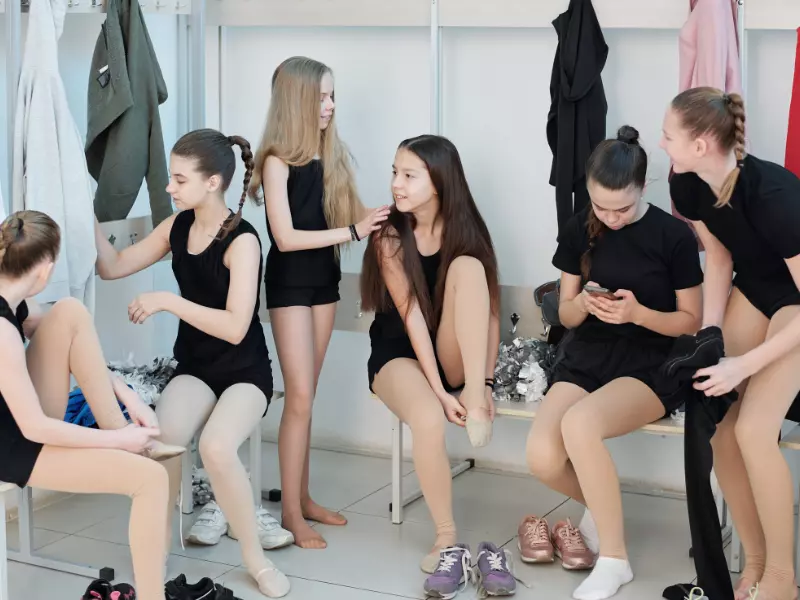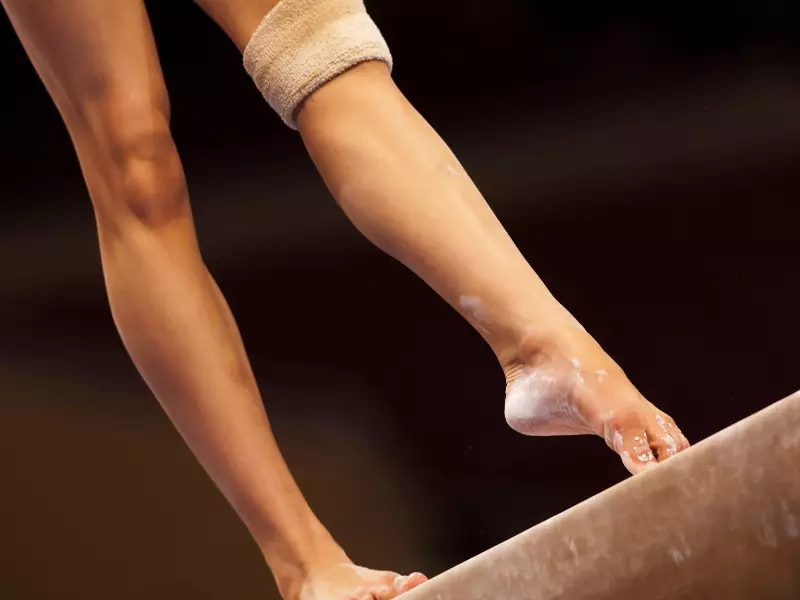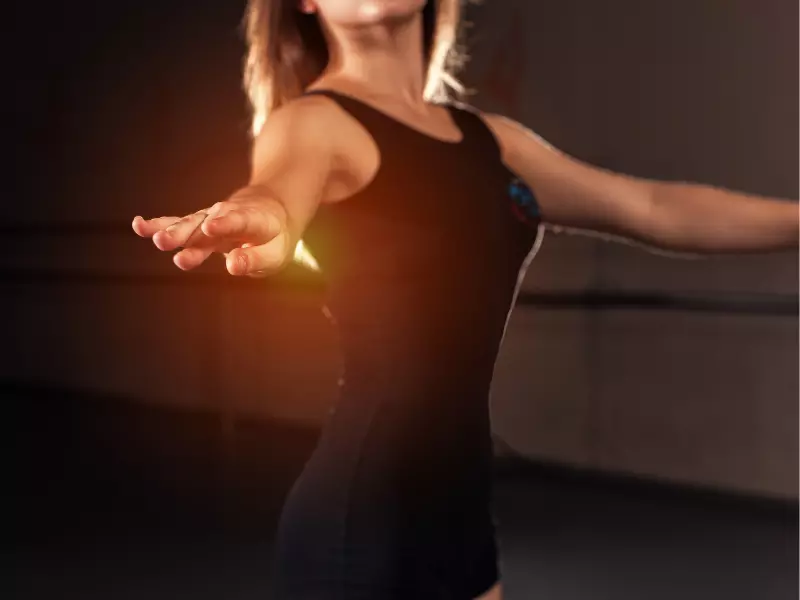Gymnasts are known for their ability to perform various complex maneuvers while wearing a leotard. The close-fitting garment helps gymnasts show off their flexibility and strength, but it must remain in place during the routine. They provide full body coverage while allowing complete freedom of movement.
In this article, we’ll explore the features of leotards and techniques used by gymnasts to ensure their garments stay in place no matter how acrobatic their routine might get.
Contents
Leap with Confidence: Uncovering Essential Leotard Features
Leotards have been an essential piece of dance and gymnastics apparel for many decades. They are comfortable, durable, and provide a second-skin fit that is tailored to the gymnasts’ body. But how do they stay up? What makes them so secure? The answer lies in their unique features.
- Design
The design of gymnastics leotards is critical as they must provide support while allowing maximum flexibility. A combination of elastic straps, strategically placed seams and strong closures all help the garment conform to the contours of the body and keep it from slipping around too much while moving.
For example, elastic straps go around the waist, chest and/or shoulders to provide a secure fit as well as comfort. Strategically placed seams help hold the fabric in place in areas where it may be prone to stretching or pulling away from the body. Finally, quality closures such as zippers, buttons and Velcro allow for further adjustment and a tailored look while also keeping everything in place.
- Fabrics
Most gymnastics leotards are made from stretchy fabrics that fit snugly around the body without constricting it, ensuring that the leotard won’t slip or come undone. These types of materials often include spandex, lycra, nylon or a combination of several different fabrics to provide comfort and support for athletes during their performances.
They also wick away moisture so athletes stay cool and dry during practice and competition. Furthermore, these fabrics are lightweight which helps reduce bulkiness – making it easier to move around without feeling weighed down by the garment itself.
- Sewing
Sewing is an important part of keeping leotards in place during a performance. By using high-quality thread and strong and reliable stitches, gymnasts can be sure that their garments won’t come undone mid-routine.
Many competitive-level leotards come with embellishments such as rhinestones and sequins, which provide additional stability when performing maneuvers like flips or tumbles. In addition, some leotards also feature removable straps or body tape for extra grip and security, preventing the garment from riding up when performing intricate moves.
End Slippage Woes: How To Choose Your Size
When it comes to finding the perfect leotard for dance or gymnastics, size is not just a matter of comfort; it’s also an important factor in avoiding slippage issues. Whether you’re a beginner or advanced dancer or gymnast, selecting the right size leotard can make all the difference in achieving your goals. Knowing how to accurately measure and choose the proper size will ensure that you have a comfortable and secure fit when performing.
Generally speaking, most leotards will fit around the hips, chest, waist, and shoulders snugly without being overly tight or uncomfortable.
Here are a few tips for selecting the right size leotard:
- Measure your bust: To measure your bust, wrap a measuring tape around the fullest part of your chest, making sure it is level and not too tight.
- Measure your waist: To measure your waist, wrap a measuring tape around the narrowest part of your waist, making sure it is level and not too tight.
- Measure your hips: To measure your hips, wrap a measuring tape around the widest part of your hips, making sure it is level and not too tight.
- Consult the size chart: Use the measurements you have taken to determine your size according to the size chart provided by the manufacturer. Keep in mind that size charts can vary from one brand to another, so it’s important to refer to the specific size chart for the brand you are considering.
- Consider the fit: When trying on leotards, be sure to consider the fit as well as the size. The leotard should fit snugly but should not be too tight. It should also be comfortable to wear and allow for a full range of motion.
Butt Glue – The Secret to Keeping Leotards in Place
Whether you’re a gymnast or just like to wear form-fitting clothing, you’ve probably heard of “butt glue.” Butt glue, also known as body glue or performance glue, is a product that is used by some gymnasts, dancers, and other performers to help keep their clothing in place.
It is a type of adhesive that is applied to the skin and is designed to create a strong, yet flexible bond between the skin and the fabric of the clothing. This glue helps them achieve maximum performance without having to worry about uncomfortable fabric bunching or shifting during flips and other maneuvers.
Here are some of the benefits of using butt glue for keeping leotards in place:
- Strong & flexible:
Butt glue is designed to create a strong, yet flexible bond between the skin and the fabric of the clothing, meaning once you apply it to your leotard it won’t budge until you take the time to remove it. This eliminates the need for constant readjusting and ensures your clothing stays securely in place no matter how intense your workout gets.
With butt glue, gymnasts don’t have to worry about their leotard shifting or bunching while they perform difficult maneuvers and stunts. The adhesive holds clothing firmly in place while allowing complete freedom of movement.
- Durable & long-lasting
Unlike pins or tape, butt glue will not damage the delicate fabric of a leotard and will remain secure throughout even the most strenuous of activities. Additionally, it helps to keep costumes looking their best since it remains virtually invisible while in use.
When properly applied, it’s strong enough to withstand hours of sweat and movement without causing irritation to sensitive skin. It also dries quickly so no need to worry about any sticky residue left behind. This makes it a convenient option for performances that may be lengthy or for athletes who need to practice or compete on multiple occasions.
- Easy to apply:
The use of butt glue is often times more convenient than traditional solutions like body tape or double-sided clothing tape. Applying butt glue does not require any specialized tools other than your own hands; simply apply the product directly onto the fabric and you’re good to go!
It is easy to apply and can be used in a variety of settings, including at home, in a dressing room, or on the competition floor. It is typically applied using a brush or spatula and can be easily removed with soap and water.
- Comfortable & Safe
Butt glue is generally comfortable to wear and does not cause irritation or discomfort when applied properly. It is made from a combination of water and polymers that create a sticky, yet non-irritating adhesive layer on the skin.
When used correctly, most butt glue products have been shown to be both safe and effective at keeping fabric in place during activities such as gymnastics competitions. Additionally, many products are hypoallergenic so those with sensitive skin can use them without worry.
Optimize Comfort with These Leotard Care Tips
Caring for a leotard properly is essential to maintain the fabric’s elasticity and durability. Knowing how to launder, store and repair leotards can keep them looking their best and will help them last longer. Here are some tips on caring for your leotard:
- Wash regularly: It’s important to wash your leotards regularly to keep them fresh and clean. Follow the care instructions provided by the manufacturer, which may include washing the leotard in cold water and tumble drying on a low setting or air drying.
- Avoid bleach and harsh detergents: To avoid damaging your leotards, avoid using bleach or harsh detergents when washing them. Instead, opt for a gentle detergent specifically designed for athletic wear.
- Avoid high heat: When drying your leotards, avoid exposing them to high heat. Tumble dry on a low setting or air dry to help preserve the integrity of the fabric.
- Avoid rough surfaces: To avoid snagging or tearing your leotards, be careful when wearing them around rough surfaces, such as metal bars or equipment.
- Repair any damage: If you notice any holes, snags, or other types of damage to your leotards, repair them as soon as possible to prevent the damage from worsening.
- Store properly: When not in use, store your leotards in a cool, dry place away from direct sunlight. Avoid folding or stacking your leotards, as this can cause creasing or wrinkling.
Conclusion
The sport of gymnastics requires a combination of physical strength, coordination, and skill. But it also calls for the right outfit: a leotard that is comfortable and secure. Through a combination of pattern design, fabric selection, and personal comfort measures, gymnasts can make sure their leotards stay put through even the most strenuous routines.


